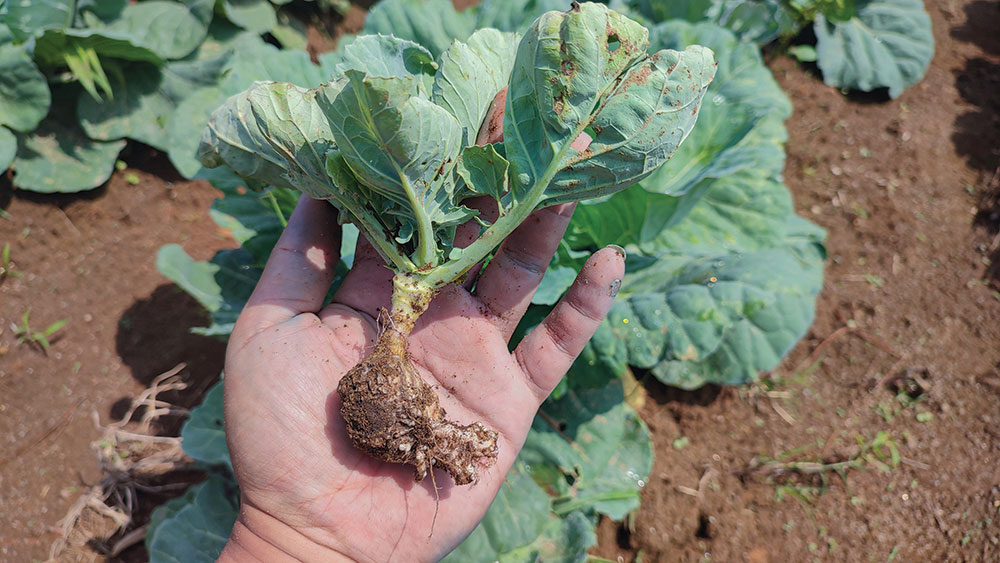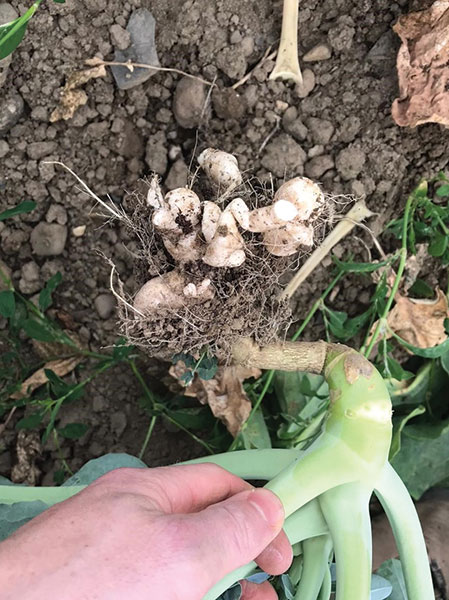01 March 2024
Root behaviour
The soilborne disease clubroot is increasingly prevalent and difficult to control. To help manage clubroot, Teagasc researchers are investigating the potential of naturally occurring predators in the soil microbiome.

Characteristic ‘clubroots’ inhibit nutrient and water uptake of affected crops
The Brassica plant family includes a large range of agriculturally important crops, which are grown as vegetable or oil crops for food, animal feed and industrial purposes (i.e. cabbage, broccoli, cauliflower, kale, rapeseed or Brussels sprouts). Clubroot is a major challenge for the production of brassicas. In Europe clubroot has affected Brassica cultivation for centuries. The exact origin of the disease is unknown, but it is believed to have spread inside Europe and from there to other parts of the world via infected plant material since the Roman era.
To date, the disease is globally present in all areas where Brassicas are cultivated, resulting in an estimated loss of 10–15% of Brassica crop production worldwide — locally, complete yield losses can occur. In Ireland, reports on the incidence of clubroot have increased, possibly related to the use of brassicas as cover crops, increased brassica weed pressure and shortening rotations due to land availability.
Arne Schwelm, a Teagsasc Research Leader, explains the details of clubroot: “The clubroot pathogen Plasmodiophora brassicae is somewhat unusual as it does not belong to the better known fungal, bacterial or oomycete plant pathogens. Instead, it is a plasmodiophorid protist, belonging to the Rhizaria. Plasmodiophorids also include other plant pathogens such as the potato powder scab agent and virus transmitter Spongospora subterranea and the virus-transmitting Polymyxa betae and Polymyxa graminis species.
“P. brassicae infection induces tumorous growth of the host roots – forming characteristic ‘clubroots’. These malformed roots inhibit nutrient and water uptake of the infected crop. P. brassicae build very resilient resting spores which allow the pathogen to survive in the soil for decades.”
Persistent pathogen
When the infected clubroots decay, fresh resting spores are reintroduced into the soil. The spores can survive and remain viable for up to 20 years, but as P. brassicae can infect all cruciferous plants, weed species — such as Charlock — and volunteer Brassicae crops can be involved in maintaining and refreshing the disease cycle. Current control strategies include pH adjustment by liming, extended crop rotation times, and developing and utilising crop varieties that are resistant to the disease. However, clubroot resistance has been overcome for both oilseed and vegetable crops resulting in more frequent occurrences of clubroot cases, including in Ireland. Fungicides have been applied in an attempt to reduce clubroot disease with limited success, likely because P. brassicae is not a fungi. While some older chemistries and soil sterilants were more successful in managing clubroot, they have subsequently been removed from the market for environmental reasons. Thus, it is crucial to explore alternative, biological approaches for more effective and sustainable ways to mitigate clubroot disease.

A typical clubroot formation
Despite its challenging biology and persistence, the resting spores of the clubroot pathogen are not without foes in the soil. Soil houses nearly 60% of all living organisms. This high biodiversity might hold the potential to help manage and mitigate clubroot. Microbiome predator species, such as protists and nematodes, could help to reduce infections by soilborne pathogens such as clubroot. Arne explains: “A reduction of a pathogen load in the soil would substantially aid any other management practices to mitigate a disease — especially when it comes to such a persistent disease as clubroot. Predators that include the pathogen in their diet might turn out to be new tiny little helpers for farmers.”
The impact of those predators on clubroot is largely unknown. But as the diet of many soil-dwelling organisms includes bacterial, fungal or oomycete pathogens, predators might equally reduce other pathogens in soils. Additionally, by selective feeding, soil predators can shape the plant-associated biodiversity towards plant-beneficial microbes or induce production of antibiotics from their prey, thereby indirectly inhibiting potential plant pathogens.
It is reasonable to consider that clubroot may be influenced by direct predation or the interactions between predators and the microbiome mentioned above, suggests Arne. “Indeed, at least in culture some protist predators can engulf the clubroot resting spores. As part of our research, we are investigating the potential roles of soil microbiome predators on the presence and longevity of clubroot. Our aim is to identify microbiome predators in clubroot suppressive soils and how they impact clubroot disease development. Potentially this could lead to the discovery of novel biocontrol species.”
By using clubroot as a model pathogen system in this research, the findings and insights gained have the potential to be applied to other challenging, soilborne plant diseases that are difficult to control.
15% of Brassica crop is lost to clubroot
Funding
Arne Schwelm has received funding from the Research Leaders 2025 programme
co-funded by Teagasc and the European Union’s Horizon 2020 Research and Innovation Programme under Marie Skłodowska-Curie grant agreement number 754380.
Contributors
Arne Schwelm
Research Leaders
2025 Programme,
Teagasc Johnstown Castle.
Stefan Geisen
Assistant Professor,
Laboratory of Nematology,
Wageningen University,
The Netherlands.
Michael Gaffney
Principal Research Officer,
Horticulture Development
Department,
Teagasc Ashtown.
Fiona Brennan
Senior Research Officer,
Teagasc Johnstown Castle.
Fiona.Brennan@teagasc.ie
[pic credit] Bert Swandi/shutterstock.com
Further reading
No rest for resting spores: Can predators mitigate clubroot disease?
